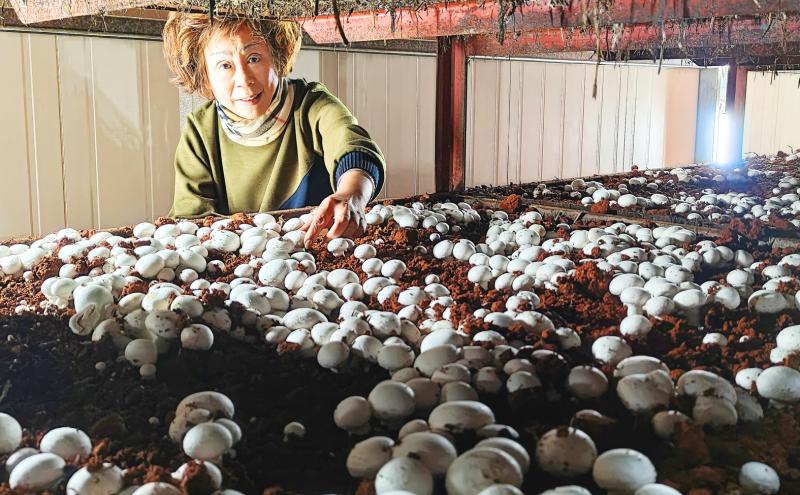Farmer Lee Mei-ling (李美玲) has revived the mushroom industry in Changhua County’s Jhutang Township (竹塘) after adding modern facilities to her traditional mushroom farm.
The township had been Taiwan’s No. 1 producer of mushrooms until 20 years ago, when it fell behind other regions that were using improved techniques to grow larger mushrooms.
The township steadily declined as a producer until it was seen as a source of cheap agricultural products.

Photo: Chen Kuan-pei, Taipei Times
However, Lee 13 years ago set off on a path that would eventually make Jhutang Township a renowned producer of mushrooms once again.
She started by renovating an old warehouse used for growing mushroom by installing air-conditioning and an environmental management system.
Lee was soon able to grow mushrooms larger than any ever grown in the township, and began receiving orders from larger markets and wholesalers.
Today, she sells 400kg of mushrooms per day — more than any other Taiwanese producer.
“The characteristics of the land in Jhutang Township, as well as the wet conditions in winter, make it ideal for growing mushrooms,” Lee said.
In the 1980s, there were 400 mushroom farms in the township, each about 50 ping (165m2), but by 20 years ago most of them had closed.
After Lee installed the environmental control system and began seeing success with her new growing techniques, she shared those techniques with others in the township, and today there are 100 thriving farms.
“However, the technology has its limitations. A northeast monsoon can destroy the crop. There are also limits to production quality, which might call for a change to the fermentation process,” she said.
Newer techniques require only 21 days for fermentation, compared with 30 days for more traditional techniques, she said, adding that some growers have also experimented with separating fermentation beds, or using amino acids in the water.
Such techniques could speed up fermentation by another week, which lessens the chance of crop damage from disease or insects, she added.
Modern environmental control systems are more environmentally friendly than the oil heaters previously used by farms, but also consume a lot of power, she said, adding that she has tackled the problem by installing solar panels.
Her farm also recycles the water produced by the air-conditioning units, she added.
The farm would remain focused on ways to further improve production quality, Lee said.

US climber Alex Honnold is to attempt to scale Taipei 101 without a rope and harness in a live Netflix special on Jan. 24, the streaming platform announced on Wednesday. Accounting for the time difference, the two-hour broadcast of Honnold’s climb, called Skyscraper Live, is to air on Jan. 23 in the US, Netflix said in a statement. Honnold, 40, was the first person ever to free solo climb the 900m El Capitan rock formation in Yosemite National Park — a feat that was recorded and later made into the 2018 documentary film Free Solo. Netflix previewed Skyscraper Live in October, after videos

Starting on Jan. 1, YouBike riders must have insurance to use the service, and a six-month trial of NT$5 coupons under certain conditions would be implemented to balance bike shortages, a joint statement from transportation departments across Taipei, New Taipei City and Taoyuan announced yesterday. The rental bike system operator said that coupons would be offered to riders to rent bikes from full stations, for riders who take out an electric-assisted bike from a full station, and for riders who return a bike to an empty station. All riders with YouBike accounts are automatically eligible for the program, and each membership account

NUMBERS IMBALANCE: More than 4 million Taiwanese have visited China this year, while only about half a million Chinese have visited here Beijing has yet to respond to Taiwan’s requests for negotiation over matters related to the recovery of cross-strait tourism, the Tourism Administration said yesterday. Taiwan’s tourism authority issued the statement after Chinese-language daily the China Times reported yesterday that the government’s policy of banning group tours to China does not stop Taiwanese from visiting the country. As of October, more than 4.2 million had traveled to China this year, exceeding last year. Beijing estimated the number of Taiwanese tourists in China could reach 4.5 million this year. By contrast, only 500,000 Chinese tourists are expected in Taiwan, the report said. The report

Temperatures are forecast to drop steadily as a continental cold air mass moves across Taiwan, with some areas also likely to see heavy rainfall, the Central Weather Administration (CWA) said. From today through early tomorrow, a cold air mass would keep temperatures low across central and northern Taiwan, and the eastern half of Taiwan proper, with isolated brief showers forecast along Keelung’s north coast, Taipei and New Taipei City’s mountainous areas and eastern Taiwan, it said. Lows of 11°C to 15°C are forecast in central and northern Taiwan, Yilan County, and the outlying Kinmen and Lienchiang (Matsu) counties, and 14°C to 17°C